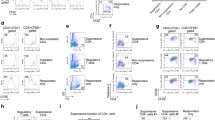Summary
Pretreatment of peripheral blood mononuclear cells (PBMC) with 5 mMl-phenylalanine methyl ester (PheOMe) provides an efficient means to deplete monocytes. PheOMe does not affect the number of large granular lymphocytes after the pretreatment, but does inhibit natural killer cell cytotoxicity temporarily after the pretreatment. However, depletion of monocytes by PheOMe allows lymphokine-activated killer (LAK) cell generation with recombinant interleukin-2 (rIL-2) at high cell density (> 5 × 106 cells/ml). The time of the PheOMe pretreatment is 40–60 min, though some effect could be observed within 15 min, and the pretreatment could be performed at room temperature. Pretreatment density of PBMC with 5 mM PheOMe could be achieved at cell density up to 3 × 107 cells/ml. PheOMe-pretreated cells could be activated by rIL-2 in serumless media at high cell density. Pretreatment of PBMC with 5 mM PheOMe provides an efficient means to deplete monocytes, as compared to plastic and nylonwool adherence. LAK cell generation is similar in both methods of monocyte depletion; therefore, depletion of monocytes allows, LAK cell generation at high cell density. The PheOMe procedure provides an improved and convenient process for preparing LAK cells for adoptive immunotherapy.
Similar content being viewed by others
References
Barlozzari T, Reynolds CW, Herberman RB (1983) In vivo role of natural killer cells: involvement of large granular lymphocytes in the clearance of tumor cells in anti-asialo GM1-treated rats. J Immunol 131: 1024
Grimm EA, Mazumder A, Zhang HZ, Rosenberg SA (1982) Lymphokine activated killer cell phenomenon. Lysis of natural killer resistant fresh solid tumor cells by interleukin-2 activated autologous human peripheral blood lymphocytes. J Exp Med 155: 1823
Helwig I, Groppe A (1972) Staining o constitutive heterochromatin in mammalian chromosomes with a new flurochrome. Exp Cell Res 75: 122
Hoyer M, Meineke T, Lewis W, Zwilling B, Rinehart J (1986) Characterization and modulation of human lymphokine (interleukin 2) activated killer cell induction. Cancer Res 46: 2834
Ibayashi Y, Hoon DSB, Golub SH (1987) The regulatory effect of adherent cells on lymphokine activated killer cells. Cell Immunol 110: 365
Kasid A, Bell GI, Director EP (1988) Effects of transforming growth factor-β on human lymphokine-activated killer cell precursors: autocrine inhibition of cellular proliferation and differentiation to immune killer cells. J Immunol 141: 690
Leung KH (1987) Improved process for preparing LAK cells byl-phenylalanine methyl ester pretreatment of peripheral blood mononuclear cells. Lymphokine Res 6, abstr 1817
Leung KH, Fischer DG, Koren HS (1983) Erythromyeloid tumor cells (K562) induce PGE synthesis in human peripheral blood monocytes. J Immunol 131: 445–449
Leung KH, Koren HS (1982) Regulation of human natural killing: II. Protective effect of interferon on NK cells from suppression by PGE2. J Immunol 129: 1742
Leung KH, Mihich E (1980) Prostaglandin modulation of development of cell-mediated immunity in culture. Nature 288: 597
Mule JJ, Ettinghausen SE, Spiess PJ, Shu S, Rosenberg SA (1986) Antitumor efficacy of lymphokine-activated killer cells and recombinant interleukin-2 in vivo: survival benefit and mechanisms of tumor escape in mice undergoing immunotherapy. Cancer Res 46: 676
Nii A, Sone S, Utsugi T, Yangawa H, Ogura T (1988) Up- and down-regulation of human lymphokine (IL-2)-activated killer cell induction by monocytes, depending on their functional state. Int J Cancer 41: 33
Phillips JH, Lanier LL (1986) Dissection of the lymphokineactivated killer phenomenon. Relative contribution of peripheral blood natural killer cells and T lymphocytes to cytolysis. J Exp Med 164: 814
Rosenberg SA, Lotze MT, Mul JJ (1988) New approaches to the immunotherapy of cancer using interleukin-2. Ann Intern Med 108: 853
Silvennoinen O, Vakkila J, Hurme M (1988) Accessory cells, dendritic cells, or monocytes, are required for the lymphokine-activated killer cell induction from resting T cell but not from natural killer cell precursors. J Immunol 141: 1404
Thiele DL, Lipsky PE (1985) Regulation of cellular function by products of lysosomal enzyme activity: elimination of human natural killer cells by a dipeptide ethyl ester generated froml-leucine methyl ester by monocytes or polymorphonuclear leukocytes. Proc Natl Acad Sci USA 82: 2468
Author information
Authors and Affiliations
Rights and permissions
About this article
Cite this article
Leung, K.H. Human lymphokine-activated killer (LAK) cells. Cancer Immunol Immunother 30, 247–253 (1989). https://doi.org/10.1007/BF01665012
Received:
Accepted:
Issue Date:
DOI: https://doi.org/10.1007/BF01665012




